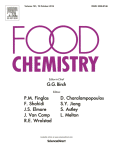Ver ítem
- xmlui.general.dspace_homeCentros e Institutos de InvestigaciónCIA. Centro de Investigaciones de AgroindustriaInstituto de Tecnología de AlimentosArtículos científicosxmlui.ArtifactBrowser.ItemViewer.trail
- Inicio
- Centros e Institutos de Investigación
- CIA. Centro de Investigaciones de Agroindustria
- Instituto de Tecnología de Alimentos
- Artículos científicos
- Ver ítem
Culinary practices mimicking a polysaccharide-rich recipe enhance the bioaccessibility of fat-soluble micronutrients
Resumen
This study was carried out to assess the impact of heat processing of a complex emulsion on the behavior of fat soluble micronutrients (FSM) in a traditional Tunisian dish. A simplified recipe involved, dried mucilage-rich jute leaves, tomato paste and olive oil, followed by a cooking treatment (150 min). Hydrothermal pattern and viscosity were monitored along with the changes of FSM content and the bioaccessibility (called micellarization, using an in
[ver mas...]
This study was carried out to assess the impact of heat processing of a complex emulsion on the behavior of fat soluble micronutrients (FSM) in a traditional Tunisian dish. A simplified recipe involved, dried mucilage-rich jute leaves, tomato paste and olive oil, followed by a cooking treatment (150 min). Hydrothermal pattern and viscosity were monitored along with the changes of FSM content and the bioaccessibility (called micellarization, using an in vitro digestion model). Partitioning of carotenoids differed according to their lipophilicity: lycopene, β-carotene and lutein diffused to the oil phase (100%, 70% and 10% respectively). In contrast with the poor carotenes/tocopherol bioaccessibility (0.9–1%), the highest micellarization was observed for lutein (57%) and it increased with heating time and viscosity change. Domestic culinary cooking practices probably increase the bioavailability of carotenes mainly by their diffusion to the oil phase, facilitating their in vivo transfer into micelles.
[Cerrar]

Autor
Dhuique-Mayer, Claudie;
Servent, Adrien;
Descalzo, Adriana Maria;
Mouquet-Rivier, Claire;
Amiot, Marie-Josèphe;
Achir, Nawel;
Fuente
Food chemistry 210 : 182-188. (November 2016)
Fecha
2016-11-01
ISSN
0308-8146
Formato
pdf
Tipo de documento
artículo
Palabras Claves
Derechos de acceso
Restringido
 Excepto donde se diga explicitamente, este item se publica bajo la siguiente descripción: Creative Commons Attribution-NonCommercial-ShareAlike 2.5 Unported (CC BY-NC-SA 2.5)
Excepto donde se diga explicitamente, este item se publica bajo la siguiente descripción: Creative Commons Attribution-NonCommercial-ShareAlike 2.5 Unported (CC BY-NC-SA 2.5)

